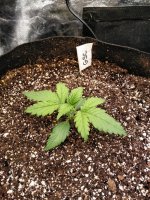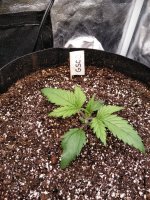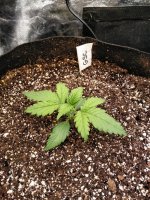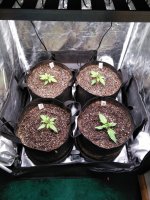I thought this was a good read.
Salts Don’t Kill Plants Or Microbes
The idea that salts kill plants and microbes seems very prevalent, especially among organic growers. The topic is poorly understood and leads to a number of statements that are either false or mostly false.
“Fertilizer kills plants because it is a salt”
“Farmer fields are devoid of microbes because of the salt in fertilizer”
“The NPK in manufactured fertilizer is made soluble by chemically attaching the NPK to salts”
“They [fertilizers] also make it easier for the chemicals to run off into waterways”
“Organic sources contain fewer salts”
“Organic sources are slow release”
“Fertilizers are designed to be highly soluble”
It’s time for a chemistry lesson to better understand salts, ions and the difference between synthetic and organic fertilizer.
What is Salt?
The general public uses the word salt to refer to table salt which is sodium chloride. Each molecule of table salt contains one atom of sodium and one atom of chlorine.
The idea that salt can harm plants is supported each winter when salt is spread on roads and sidewalks as a deicer. The salt washes into the soil next to the road and plants growing there can be harmed or even killed. Historically this salt was sodium chloride, but some communities now use calcium chloride which is less harmful to plants.
Salt also affects plants growing next to oceans where the wind blows sea salt inland. Sea salt is also sodium chloride and people who garden in such locations need to be careful to use salt-tolerant plants, or else the plants die. The native plants along the coast are more immune to the salt – they find it less toxic.
That last sentence is very important. Although sodium chloride will harm plants, each type of plant has a certain immunity to salt. It is the dose (ie the amount) of salt that is important. A small amount will not harm a plant. A bit more may start having effects, and once the dose reaches a critical level it will kill the plant.
The Chemists View of Salt
Chemists use the word salt quite differently. For them, a salt is any molecule that is made up of two or more ions. Sodium chloride (NaCl) is made up of two ions; sodium and chlorine. Ammonium nitrate (NH4NO3) is also a salt and is made up of an ammonium ion (NH4) and a nitrate ion (NO3). Potassium chloride (KCl) is common in fertilizer and is made up of a potassium ion (K) and a chlorine ion (Cl). There are hundreds of different salts.
As a solid, the ions join together to form crystals and chemists call these salts. When salts are dissolved in water, the ions in the salt separate and are no longer joined together. They are now properly called ions, not salt. This may seem like silly semantics, but it is an important distinction for properly understanding the effect of salts on soil and plants.
Once salt hits the soil, it dissolves in the soil water fairly quickly – almost instantly if it rains. Because of this, most soil does not contain salt – only ions. Once in solution these ions now acts as separate molecules. The nitrate ion goes off and does its own thing, as does the potassium ion, the calcium ion and so on. Each ion has different chemical and physical properties in soil.
Some ions like phosphate stick tightly to soil and even rain does not move it very far. Nitrate on the other hand is very soluble, does not stick to soil, and quickly moves with the water.
What Are Ions?
Ions are molecules that either have extra electrons or have lost electronics. Therefore they are charged particles. A sodium ion is more correctly written as Na+, because it has lost an electron and now has a positive charge. Chlorine is Cl- since it has gained an electron. Salts are formed when negative ions (anions) and positive ions (cations) join together and neutralize the charge (ie salt has a zero charge).
Nutrients vs Ions
What is the different between nutrients and ions? Nothing really. Gardeners use the term nutrients to refer to the food that plants absorb through the roots and most nutrients are ions.
We talk about plants needing nitrogen, but plants can’t actually use nitrogen. Instead, they absorb nitrate ions (NO3) which contain nitrogen and oxygen. Once inside the plant, they separate the nitrogen from the oxygen and use it. The same goes for sulfur which is absorbed as a sulfate ion (SO4) and phosphorus which is absorbed as a phosphate ion (PO4). Other nutrients like potassium, iron, magnesium are absorbed as simple ions that don’t include the oxygen.
The key point here is that the nutrients which plants use, are exactly the same as the ions resulting from fertilizer salts. They are identical!
What About Organic Nutrients
Organic material consist of whole cells that contain big molecules. DNA contains phosphorus. Proteins contain sulfur and nitrogen. Chlorophyll contains magnesium and nitrogen. Organic material also contains loose ions floating around the cells, waiting to be used to produce larger molecules.
What happens when a plant dies? Initially not much. The cells are still intact and they just sit there. As time goes by microbes move in and start to break down the plant. Fairly quickly, the cell membrane is damaged and the loose ions floating inside cells are released. It is similar to biting into a jelly doughnut – the insides squish out as soon as you bite into it.
These loose ions are exactly the same as they were when the roots absorbed them. They are also the same as the ions that were released from fertilizer.
As decomposition continues, microbes digest the larger molecules and eventually the phosphorus in DNA and the nitrogen in proteins is released into the soil as nitrate and phosphate ions. The important point is that these ions are no different than the ions absorbed by roots or the ions from fertilizer.
The ions from organic sources are exactly the same as the ions from fertilizer.
Do Salts Kill Plants?
Remember that each ion has its own chemical and physical property. Each one affects soil and plants differently and some ions are more toxic to plants than others. It turns out that sodium is very toxic to most plants, even at low levels. It does not take much sodium to kill plants along the roadway where salt is used as a deicer and it quickly kills some plants along the seashore. But sodium is also used as a nutrient by some plants. It all comes down to dose. Small amounts can be beneficial for certain plants and too much kills them.
Nitrates are similar. If you put too much on your lawn you will burn the grass – which is just another way of saying you killed your grass. But grass, just like every other plant, can’t grow without nitrates.
Every ion in fertilizer is both a food source for plants at low levels and a toxin at high levels. Each ion has a different level of toxicity. Calcium, for example, can be quite high and has almost no effect on plants.
When salts (ie fertilizer) are added to soil in reasonable amounts it feeds plants and is not toxic to them. Plants can’t grow without them.
Does Organic Material Contain Salts?
Not in the strict sense of the word. Salts are solids and the loose stuff inside plant cells is dissolved in water – they are ions. So strictly speaking organic matter does not contains salts.
Organic material like manure has a lot of loose ions floating around, and some people incorrectly refer to them as salts. These ions can be in high concentrations and this is why fresh manure needs to be used cautiously in gardens. High levels of ions become toxic to plants.
Soil and Ions
It is also important to understand that soil contains lots of ions. Clay soil usually has a very high level because ions stick to clay. Sand has very low levels since they don’t stick to sand very well and water washes the ions away. This is why clay soil is very nutritious for plants and sandy soil is not.
Ions that are added to soil through fertilizer or organic material, tend to stick to soil and if they are not used by plants or microbes, the amount builds up and can reach toxic levels. This is why you need to be very careful about adding too much fertilizer or organic matter.
Do Salts Kill Microbes?
Plants and animals all require ions as a food source. Microbes are no different. They need phosphates and nitrates to build DNA and proteins. Without ions, microbes can’t live and just like plants, too much of a good thing becomes toxic.
When fertilizer is used in reasonable amounts it actually causes the microbe population in soil to increase – not decrease – contrary to what so many organic followers believe.
Fertilizer Myths
At the beginning of this post I mentioned some quotes.
“The NPK in manufactured fertilizer is made soluble by chemically attaching the NPK to salts”. This one is silly. The NPK are salts, they are not attached to salts. The fertilizer industry does select salts that are more soluble so they enter the soil more easily. That is a good thing – what is the point of having them sit on top of the soil?
“They [fertilizers] also make it easier for the chemicals to run off into waterways” . Since the ions in organic matter and fertilizer are the same, they run off into waterways in exactly the same way. The key here is to add them so that they get used up before they have a chance to run away.
“Organic sources contain fewer salts”. This one is sort of true. If you take 100 g of a 10-10-10 fertilizer and compare it to compost which is 1-1-1, the fertilizer has more salt. But this is a silly comparison. It is like saying a bag of 10 apples contains more apples than a bag of one apple. It is more correct to think of it this way. If both fertilizers contain the same amount of nutrients, they have exactly the same amount of salts/ions.
“Organic sources are slower release”. This one is partially correct. Remember that organic matter contains free ions as well as ions tied up in large molecules. The free ions are released almost instantly – they are not slow release. The ones in large molecules will be released slowly over years.
“Fertilizers are designed to be highly soluble”. They are not designed to be very soluble – most salts are soluble – it is part of their chemical characteristic. Some salts are more soluble than others. For example carbonates and phosphates are much less soluble than chlorides and nitrates. But why is this an issue? The point of using fertilizer is to get ions to plant roots. A more soluble fertilizer does this better.






